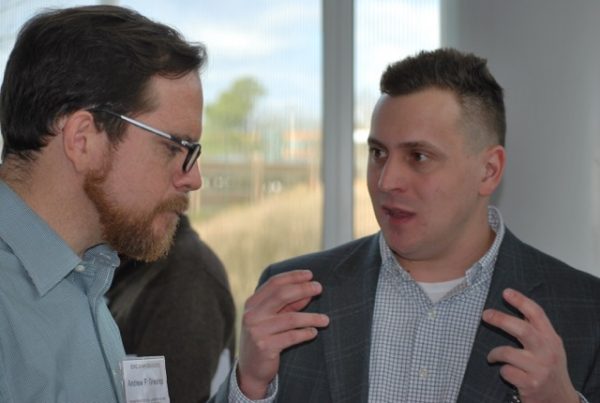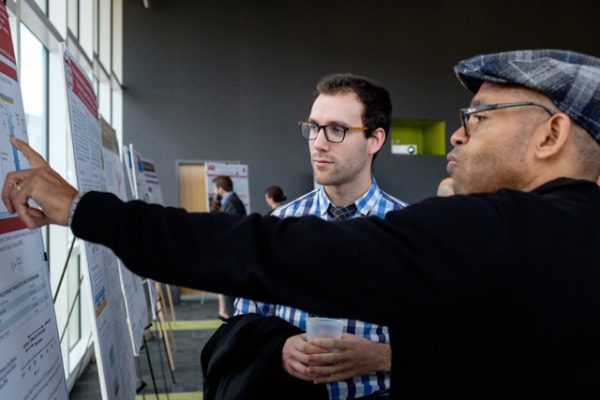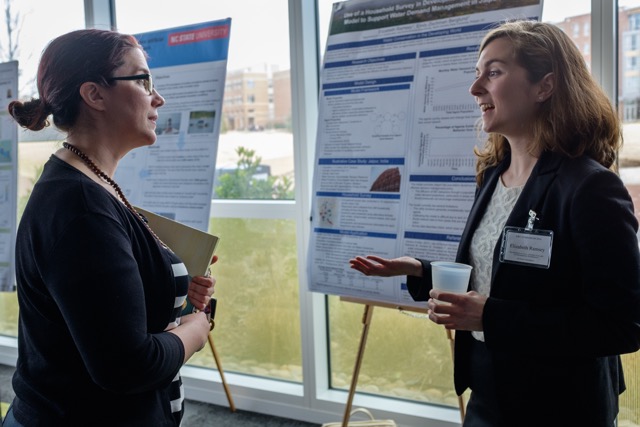The walls of the Duke Energy Hall in Hunt Library were lined with almost fifty colorful posters exhibiting the research of Masters and PhD students in the Environmental, Water Resources and Coastal (EWC) Engineering Group within the Department of Civil, Construction, and Environmental Engineering. The annual EWC Research Symposium offers graduate students a chance to present their research to fellow students, faculty, and a carefully chosen panel of judges. Students have a chance to demonstrate the most important aspects of their research and to hone their poster designing and public speaking skills.
Dr. Tarek Aziz describes the poster symposium as a valuable experience for graduate students. “Students get to come out of the lab and see what their peers are working on. It’s also a great chance to see our alumni and let local practitioners see what we are doing.”
Johnsie Lang is a PhD candidate who presented a poster and helped organize the event. She expressed her excitement about the symposium. “It’s a great opportunity for grad students to get together and discuss research.”

The Symposium is held in Spring to coincide with the graduate recruiting schedule, providing some of the top applicants with a chance to evaluate our graduate program. This year 16 recruits spent much of Friday and Saturday meeting professors, touring labs, and spending time with currently enrolled graduate students. Visiting student Eric Land remarked on the diversity of projects. “It is an exciting and diverse collection of collaborative projects. I’m impressed with the integration across the department and the generally applied nature of the research. It’s clearly not being done in a vacuum.”
A panel of 24 judges from engineering consulting firms, research agencies, and the City of Raleigh spent several hours evaluating posters. The panel convened to tally points and share observations, and seven finalists were chosen. Each of the finalists was given three minutes to summarize their purpose and the findings of their studies. This year’s finalists included the following students:
Laura Garcia–Cuerva, “Exploring Stormwater Management Strategies Through LID Implementation in Underprivileged Communities of Urbanizing Watersheds,” advised by Emily Berglund.
Harold Hounwanou, “Optimizing Factors of Flocculation of Sediment in Construction Sites Runoff,” advised by Detlef Knappe and Richard McLoughlin.
Zack Hopkins, “Effectiveness of Advanced Oxidation Processes for 1,4-dioxane Control,” advised by Detlef Knappe.
Amanda Karam, “Photochemical Micro Sensors for Evaluating Light Distributions within Photosynthetic Bioreactors for Biofuel Production,” advised by Joel Ducoste, Francis de los Reyes, Ranji Ranjithan, Jim Levis.
Ayse Karanci, “Agent-based Model to Evaluate Land Occupation Dynamics of Coastal Communities,” advised by Margery Overton.
Catalina Lopez-Velandia, “1,4 Dioxane: Occurrence, Sources and Treatment Options for an Emerging Surface Water Contaminant,” advised by Detlef Knappe.
Ling Wang, “Who’s Doing What and Why: Understanding Microbial Community Assembly and Functional Dynamics to Increase Stability and Functionality of Anaerobic Co-digesters Treating Lipid-rich Materials, advised by Tarek Aziz, Joel Ducoste and Francis de los Reyes.

After hearing the presentations from each of the seven finalists, the judges again convened and tallied points. The top honor went to Catalina Lopez-Velandia, while a three way tie was declared for second place including Harold Hounwanou, Zack Hopkins and Ling Wang. An additional award for ‘Innovation Ready for Practice’ was sponsored by the Research Triangle Park Chapter of the Air & Waste Management Association (RTP AWMA). This award met with a two-way tie between Harold Hounwanou and Ayse Karanci.
This year’s keynote speaker was Dr. Tami Bond, Nathan M. Newmark Distinguished Professor of Civil and Environmental Engineering from the University of Illinois at Urbana-Champaign, and a 2014 John D. and Catherine T. MacArthur Fellow. She spoke regarding “The Anthropocene Era and Energy for the Bottom Billion.” She urged the audience to think more critically about the role that energy, and especially energy from fire, plays in the quest to survive by billions of earth’s population. Those of us in the developed world don’t “see” fire, or combustion, that is providing our energy, because it is hidden inside our car engines or kept far away in a distant power plant. However, for those in economically poorer, developing nations, fire is still a central and visible part of their lives. For example, millions cook and heat and light their homes using crude cookstoves that burn wood, charcoal, or dung. One major thrust of Dr. Bond’s research is aimed at understanding how to measure and mitigate emissions from cookstoves and other combustion sources. These emissions are both a human health issue and a major cause of climate change.
Bond’s research is closely related to the work of CCEE faculty Dr. Andy Grieshop. Each have projects that include laboratory and field testing of cook stove emissions, and both have similar results showing that the emissions factors are much higher in field tests than in laboratory tests. “We have to engage our stakeholders,” Dr. Bond emphasized. “We have to get out of the ivory tower and engage people living in these areas to help us gather the data and solve the problems.” She went on to say that she figures she spends about 90% of her time analyzing data, and 10% talking to the people who could use the data. “I would like to reverse that,” she proclaimed.
The Symposium was sponsored by McKim and Creed, Freese and Nichols, Hazen and Sawyer, CDM Smith, EREF, Geosyntec, AECOM, Dewberry, Smith Gardner, O’Brien and Gere, SCS Engineering, and RTP AWMA.

